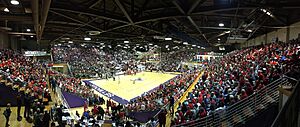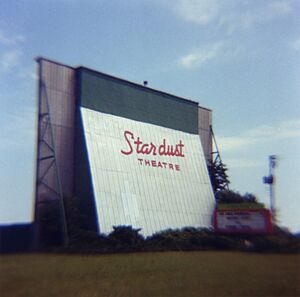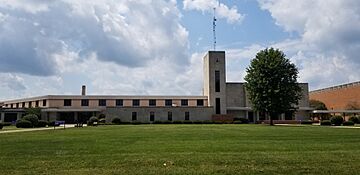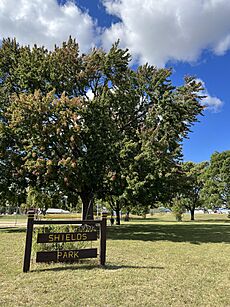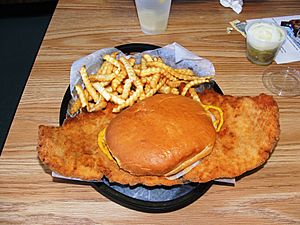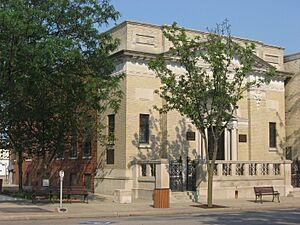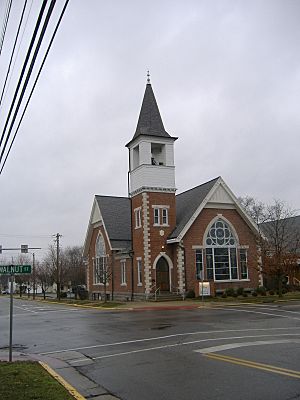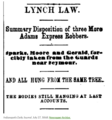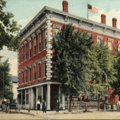Seymour, Indiana facts for kids
Quick facts for kids
Seymour, Indiana
|
|
|---|---|
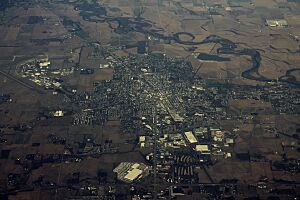
Aerial view of Seymour
|
|
| Nickname(s):
"Crossroads of Southern Indiana"
|
|
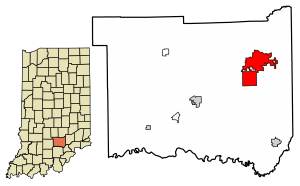
Location of Seymour in Jackson County, Indiana.
|
|
| Country | |
| State | |
| County | Jackson |
| Townships | Jackson, Redding, Rockford |
| Founding | April 27, 1852 |
| Incorporated (town) | April 27, 1852 |
| Incorporated (city) | 1864 |
| Founded by | Meedy Shields |
| Named for | Hezekiah Cook Seymour, Civil Engineer |
| Government | |
| • Type | Mayor–council |
| Area | |
| • City | 11.425 sq mi (29.59 km2) |
| • Land | 11.42 sq mi (31.42 km2) |
| • Water | 0.005 sq mi (0.01 km2) |
| Elevation | 581 ft (177 m) |
| Population
(2020)
|
|
| • City | 21,569 |
| • Density | 1,777.86/sq mi (686.41/km2) |
| • Urban | 21,579 |
| Time zone | UTC−05:00 (EST) |
| • Summer (DST) | UTC−04:00 (EDT) |
| ZIP Codes |
ZIP codes
47274
|
| Area code(s) | 812 & 930 |
| FIPS code | 18-68832 |
| GNIS feature ID | 2395850 |
Seymour is a city in Jackson County, Indiana, United States. In 2020, its population was 21,569 people.
The city is famous for being where two major railroads cross. One line runs north-south, and the other runs east-west. These railroads meet right in the downtown area. The north-south line was built in the 1840s. It connected Indianapolis to the Ohio River at Jeffersonville.
In 1852, a man named Captain Meedy Shields convinced Hezekiah Cook Seymour to build the east-west railroad through his land. In return, Shields named the new city "Seymour" in his honor. The first people settled here in the spring of 1853.
Today, big companies like Aisin USA and Rose Acre Farms have their main offices in Seymour. Cummins also has a factory nearby. Walmart runs a large distribution center east of the city. This center is close to where I-65 and US-50 meet. Seymour is also home to the second largest high school gym in the United States. The city also has a historic airport that was once a military airbase during World War II.
Contents
- History of Seymour
- Folklore and Legends
- Geography of Seymour
- Population and People
- Economy and Jobs
- Education in Seymour
- Parks and Fun Activities
- Culture and Traditions
- Historic Places and Buildings
- Transportation in Seymour
- Famous People from Seymour
- Notable Groups and Organizations
- Nearby Places to Visit
- Local Media
- Images for kids
- See also
History of Seymour
Early Days and Founding
The land around Seymour was first home to the Cherokee people. In 1805, the Treaty of Grouseland allowed white settlers to move into the area. After some conflicts, the land became more peaceful for settlement.
Seymour was officially planned and mapped out on April 27, 1852. This was done by Meedy and Eliza Ewing Shields. Their land was near an old Indian treaty corner. A north-south railroad already crossed the Shields' farm. In 1852, an east-west railroad was being planned. Meedy Shields convinced the Ohio and Mississippi Rail Road to build through his property. He agreed to name the town after the railroad's engineer, Hezekiah Cook Seymour.
The first settlers arrived in the spring of 1853. On June 29, 1854, the first train on the new Ohio and Mississippi Railroad stopped in Seymour. A celebration with a cannon shot went wrong, and four men died.
At first, Seymour grew slowly. People even called it a "mule crossing." But in 1857, a new state law changed things. This law, pushed by Meedy Shields, made all trains stop at railroad crossings. This made these areas safer and better for businesses.
Meedy Shields also offered free land and money to churches that would build in Seymour. The Presbyterian Church was the first to accept in 1855. By 1858, the first mill, Blish Mill, opened. By 1881, Seymour had three mills. A large grain tower from that time still stands near the railroad crossing.
Seymour was also a stop on the Underground Railroad. This was a secret network that helped people escape slavery. In 1860, a package meant for a famous abolitionist, Levi Coffin, opened in Seymour. Inside was a person seeking freedom. Even though Indiana was a "free state," laws made it hard for African Americans to settle there. The person was arrested and returned.
Seymour During the Civil War
During the American Civil War, Seymour and the surrounding area strongly supported the Union Army. Volunteers from Seymour formed three infantry groups. These groups trained at Camp Heffron in Seymour.
Seymour was important during the war because of its railroads. It was a key stop for moving soldiers and supplies. In 1864, six Confederate prisoners escaped while being moved through Seymour. One was caught in town.
Many local men served bravely. Colonel Samuel T. Wells, a local hero, led one regiment. Overall, Seymour and Jackson County sent 2,571 volunteers to fight for the Union.
Growth and Changes in the Late 1800s
After the Civil War, local veterans formed a group called the Ellsworth Post 20 of the Grand Army of the Republic. This group helped veterans and organized events like Memorial Day.
Around 1876, about 500 railroad workers went on strike in Seymour. They had not been paid for over two months. All train services stopped during the strike.
Seymour's first high school was built in 1871. Later, Frank B. Shields, a Seymour native and inventor of Barbasol shaving cream, donated land for the James Shields memorial gym.
By 1880, Seymour had nearly 5,000 people. It had four schools and four hotels. Many Dutch and German families moved to Seymour around this time. They were mostly Lutheran and started many successful farms and businesses. Their influence is still seen today in the city's annual Oktoberfest.
Seymour in the 20th Century
The Seymour Reds, a minor league baseball team, started in 1900. Famous baseball player Pee Wee Reese once played for them.
The Seymour Public Library opened in 1905. It was built with a grant from the Carnegie Foundation. This was part of a larger effort to build libraries across Indiana.
In 1913, the Great Flood caused a lot of damage and deaths in Seymour. It was the worst natural disaster the area had ever seen.
In 1914, artist H. Vance Swope, who grew up in Seymour, donated many of his paintings to the city. These works became part of the H. Vance Swope Gallery in the Public Library.
World War I and II
During World War I, nine Seymour natives died in combat. In 1915, Eldridge Blish Thompson, a leading businessman, died when the ship RMS Lusitania sank. This event helped lead the U.S. into the war.
During World War II, the U.S. government bought land southwest of town for an airfield. This became Freeman Army Airfield, which operated from 1942 to 1946. It was first used to train pilots for large aircraft.
Freeman Army Airfield was also the first helicopter base in the U.S. Six Sikorsky R-4 helicopters were flown there for training. This was the longest helicopter flight at the time.
In 1945, the Freeman Field Mutiny happened here. African American soldiers tried to use an all-white officers' club. This event was an important step in the Civil Rights Movement. It helped lead to the military becoming fully integrated. Future astronaut Gus Grissom trained at Freeman Field in 1944.
Mid-Century Changes
In June 1952, Seymour celebrated its 100th birthday with a week-long party. It included concerts, parades, and a play about the city's history.
In 1959, the old Shields High School closed. Students moved to the new Seymour High School. By 1970, the school built the second-largest high school gym in the U.S. In 1981, it was named the "Lloyd E Scott" gymnasium.
In 1965, Colonel Sanders, the founder of KFC, became a member of the local Elks Club in Seymour. He had family in town.
Seven Seymour soldiers died during the Vietnam War.
Late 20th Century
In 1970, Rock and Roll Hall of Famer John Mellencamp graduated from Seymour High School. He later became a famous musician. In 1976, Seymour dedicated its Oktoberfest parade to him.
In 1985, Mellencamp released "Small Town", a song about his hometown. It became a hit. Many of his music videos were filmed around Seymour. This helped people learn about life in rural America and Seymour.
Future Indiana University basketball coach Teri Moren graduated from Seymour High School in 1987. She was a star player for the Seymour Owls.
In 1989, the Stardust Theater, a popular drive-in movie theater, closed. The land was sold to build an outlet mall.
The 1990s saw the loss of several historic downtown buildings. The Lynn Hotel collapsed in 1991. The Vondee Theater was torn down in 1993. The historic Walton Hotel burned down in 1998.
Seymour in the 21st Century
In 1986, Aisin built a factory in Seymour. Production started in 1989. This brought many jobs to the city. By 2020, Aisin employed over 2,000 local residents. This factory makes parts for major car companies like Honda and Toyota.
The north-south railroad line serving Seymour was bought by the Louisville and Indiana Railroad in 1994. The Seymour Diamond Crossing is a great spot to watch trains.
Since 1989, many people from San Sebastián Coatán, Guatemala, have moved to Seymour. They came seeking a better life. By 2020, immigrants from Guatemala made up over 10% of Seymour's population.
In November 2019, a large mural of John Mellencamp was painted on a guitar store downtown. Mellencamp's family helped fund a green space around the mural for people to enjoy.
Folklore and Legends
Seymour has some interesting local legends.
Hangman's Crossing and the Reno Gang
Hangman's Crossing is a place west of Seymour. Legend says a beech tree there was where the famous Reno Gang was hanged by a group of local people. The exact spot of the tree is now lost. Some say the tree never grew leaves again after the hangings.
Local stories say the Reno Gang buried $96,000 from their last train robbery somewhere near Seymour. People used to search for coins near the old Reno home.
After they were executed, the Reno Brothers were supposedly buried under one stone in the old city cemetery. People did not want their relatives buried near them. So, the Riverview Cemetery was built. Later, a special plot for the Reno Brothers was made in the old cemetery to attract visitors.
The Blue Hole Quarry Train Mystery
Another legend tells of a train that disappeared into the Blue Hole Quarry in 1913. During a big rainstorm and flood, the train trestle washed away. The train, its crew, and a passenger car fell into the quarry. Despite many searches, the train and its crew have never been found.
Martha's Grave
In 2001, the Seymour Tribune shared stories about "Martha's Grave." This is said to be the burial site of an old witch. People claim you can see her face in the moss on the north side of her tombstone.
Buried Nazi Aircraft
After World War II, Freeman Field was home to captured Nazi aircraft. This included jet aircraft and V-1 and V-2 rockets. When the base closed, the commander reportedly ordered many of these aircraft to be buried at the site.
Geography of Seymour
Seymour is located at 38°57′26″N 85°53′20″W / 38.95722°N 85.88889°W.
In 2010, Seymour covered about 11.425 square miles. Almost all of this (99.96%) is land, with a very small amount of water.
Land and Rivers
The soil in Seymour is sandy but good for farming and raising animals. The area's landscape is shaped by the East Fork of the White River. This river moves slowly and often floods. On average, it rises above flood levels 19 days each year. There have been at least three major floods since 1900.
Population and People
| Historical population | |||
|---|---|---|---|
| Census | Pop. | %± | |
| 1860 | 966 | — | |
| 1870 | 2,372 | 145.5% | |
| 1880 | 4,250 | 79.2% | |
| 1890 | 5,337 | 25.6% | |
| 1900 | 6,445 | 20.8% | |
| 1910 | 6,305 | −2.2% | |
| 1920 | 7,348 | 16.5% | |
| 1930 | 7,508 | 2.2% | |
| 1940 | 8,620 | 14.8% | |
| 1950 | 9,629 | 11.7% | |
| 1960 | 11,629 | 20.8% | |
| 1970 | 13,352 | 14.8% | |
| 1980 | 15,050 | 12.7% | |
| 1990 | 15,576 | 3.5% | |
| 2000 | 18,101 | 16.2% | |
| 2010 | 17,503 | −3.3% | |
| 2020 | 21,569 | 23.2% | |
| Source: US Census Bureau | |||
What the 2020 Census Shows
In 2020, Seymour had 21,569 people and 7,866 households. The city's population density was about 1,533 people per square mile. Most residents (82.2%) were White. About 13.0% of the population was Hispanic or Latino.
The average household income in Seymour was $47,949. This is less than the state average for Indiana, which was $62,743. A large part of the population (39%) worked in manufacturing. Another 17.4% worked in education or healthcare.
The average age in Seymour was 34.4 years. About 28.4% of residents were under 18. About 7% of the population were military veterans.
Economy and Jobs
Seymour's economy mainly relies on manufacturing, distribution, healthcare, and education.
Major Employers
- Aisin USA: A big company that makes car parts.
- Cummins: A well-known engine manufacturer.
- Valeo North America: Another automotive supplier.
- The Lannett Company: A pharmaceutical company.
- Silgas Plastics: A plastics manufacturer.
- Nippon Steel Pipe: Makes steel tubing for cars.
Because Seymour is close to I-65 and US-50, it's a good place for distribution centers. Walmart Transportation and Pet Supplies Plus have large operations here. The Walmart Distribution Center handles merchandise for all Wal-Mart stores.
Schneck Medical Center is a major healthcare provider. It employs over 1,100 people and has been open for over 100 years. The Seymour Community Schools and Rose Acre Farms are also big employers.
Other jobs are in retail and service industries. These include many restaurants along US-50.
Education in Seymour
Seymour Community Schools runs Seymour High School and eight other schools. Over 5,000 students attend these schools. The school system employs 650 people. A public board of seven community members manages the schools.
Private Schools
- Trinity Lutheran High School: This private school is for grades 9–12. It opened in 2000 on a new 41-acre campus. It is owned by 14 Lutheran churches in the area.
- Immanuel Lutheran School: This school provides private education for grades K-8. It offers a full arts program, including music and band.
- St. Ambrose Catholic School: This private school is linked to St. Ambrose Church. It opened its current building in 1958. It offers classes in both English and Spanish for students in grades K-8.
The Seymour Public Library is a branch of the Jackson County Public Library.
Parks and Fun Activities
Seymour's recreation department manages five parks. These include the 12-acre Shields Park, which has a skate park and a public swimming pool. Shields Park is the city's oldest public park.
Gaiser Park was donated in 1924. Kessler Park was donated in 1978.
The department also manages three plazas. One is Mellencamp Plaza, located below the large John Mellencamp mural downtown. There are also 14 miles of bike and walking trails around the city.
Culture and Traditions
Arts and Entertainment
The Actors Community Theatre of Seymour (ACTS) is a non-profit group. It started in 2013 and puts on many plays. Its goal is to keep theater alive in the area.
The Southern Indiana Center for the Arts (SICA) is another non-profit. The Mellencamp family has owned it since 1991. It offers art education and promotes art in Jackson County.
Festivals and Events
The Oktoberfest celebrates Seymour's German heritage. It has been held every year since 1973. The festival features Bavarian music, carnival rides, food, and parades.
Scoop the Loop is a car show that started in 2011. It brings back the tradition of cruising downtown. In the past, teenagers from many counties would come to Seymour to show off their cars. Now, local businesses support the event to bring people downtown.
The H. Vance Swope Memorial Art Gallery has many works by local artists. It also has a large collection of landscape paintings by H. Vance Swope.
Local Food Favorites
Seymour is known for its comfort food.
- The Townhouse Cafe: Opened in 1962, it's famous for breakfast and home cooking.
- The Fish Stand: Also opened in 1962, this small place on Ewing Street serves fried fish and comfort food.
- Larrison's Diner: This diner has served burgers, fries, and tenderloin sandwiches for over 50 years. It was even a filming location for a John Mellencamp movie. Fans often visit hoping to see him.
Until 2019, Seymour was the last town in the U.S. to celebrate Victory over Japan Day with a parade. The parade ran for 73 years.
Seymour also has many social and service groups. These include the Elks Lodge, Lions Club, and Rotary Society.
Historic Places and Buildings
Seymour has six buildings listed on the National Register of Historic Places.
- Farmers Club: Built by the Blish family, this building was a memorial to city founder Meedy Shields. It opened in 1914. It has also housed the Red Cross and the Seymour Police Department.
- First Presbyterian Church of Seymour: Built in 1884, this church has a beautiful Gothic Style design. It has stained glass windows and was once the tallest spire in the city.
- T. Harlan and Helen Montgomery House: This historic home was built in the Dutch Colonial Revival style.
- Seymour Commercial Historic District: This area includes 79 historic buildings in downtown Seymour. They show different styles of architecture from 1876 to 1945.
- Southern Indiana Railroad Freighthouse: This old freight house has been the Jackson County Visitor Center since 2008.

- George H. Vehslage House: This historic home was built in 1894 in the Queen Anne style.
Other Important Buildings
- John Mellencamp's Boyhood Home: Located at 714 W Fifth Street, this was the musician's childhood home.
- Travis Carter House: Built in 1852, this is the oldest building still standing in Seymour.
- Blish Mill Grain Towers: These are the tallest structures in town. They operated as a mill from 1858 to 1976.
- Federal Building: Built in 1915, it was once the post office and police station. It is now being restored as the Seymour Museum Center.
- James Shields Memorial Gym: Built in 1941, this was one of Indiana's largest high school gyms. It is now empty and needs repairs.
Transportation in Seymour
Railroads
Seymour is a hub for several railroads:
- The Pennsylvania Railroad (formerly the Jeffersonville Railroad).
- The Ohio and Mississippi Railway, now operated by CSX.
- The Evansville & Richmond Railroad, also known as "the Milwaukee," which closed operations east of Seymour in 1961.
- The Interstate Public Service interurban lines, which stopped running in 1941.
Major Roads
 Interstate 65
Interstate 65 U.S. Route 31
U.S. Route 31 U.S. Route 50
U.S. Route 50 State Road 11
State Road 11 State Road 258
State Road 258 State Road 160
State Road 160 State Road 250
State Road 250 State Road 256
State Road 256
Famous People from Seymour
Many notable people have connections to Seymour:
- J. Ottis Adams: An American impressionist painter.
- H. Foster Bain: A geologist and former Director of the U.S. Bureau of Mines.
- Christopher Ryan Baker: A professional golfer.
- Danny "the Damaja" Basham: A professional wrestler.
- John Bell Blish: Inventor of a part for the Thompson submachine gun.
- Royce Campbell: A jazz guitarist.
- Hoagy Carmichael: A jazz musician who often visited the Blish family.
- Clessie Cummins: The founder of Cummins, who once worked for the Blish family.
- Larry Crane: An American musician.
- John Dittmer: An award-winning civil rights historian.
- Scott Earl: A retired MLB second baseman.
- Frank K. Edmondson: An American astronomer.
- George Green: Songwriting partner of John Mellencamp.
- Betty Grissom: Wife of astronaut Gus Grissom.
- Baron Hill: A former U.S. Representative.
- Thomas M. Honan: A former Indiana Attorney General.
- John Mellencamp: A famous musician, singer-songwriter, painter, and actor.
- Lisa Kennedy Montgomery: A political commentator and radio personality.
- Oscar H. Montgomery: A Justice of the Indiana Supreme Court.
- Teri Moren: The head coach for the Indiana University women's basketball team.
- Pee Wee Reese: A famous American baseball player who played for the Seymour Reds.
- Rip Rogers: A retired professional wrestler.
- Colonel Harland Sanders: The founder of KFC.
- Meedy Shields: The pioneer, town founder, and influential state senator.
- Katie Stam: Miss America 2009.
- Edgar Whitcomb: The 43rd Governor of Indiana.
- Rob Wiethoff: An actor, known for his role as John Marston in Red Dead Redemption.
Notable Groups and Organizations
- The Elms: A rock and roll band active from 2000 to 2010.
- Reno Gang: This group committed the first peacetime train robbery in the United States in Seymour in 1866.
Nearby Places to Visit
- Bell Ford Bridge: A historic covered bridge.
- Freeman Municipal Airport: A public airport, once known as Freeman Army Airfield during World War II.
- Hoosier National Forest: A large forest managed by the United States Forest Service.
- Jackson–Washington State Forest: A state forest.
- Muscatatuck National Wildlife Refuge: A wildlife refuge east of downtown.
- Starve Hollow State Recreation Area: A state recreation area.
Local Media
Radio Stations
- WLCL: 93.9 FM
- WXKU: 92.7 FM
- WZZB: 1390 AM and 99.3 FM
- WJAA: 96.3 FM
- W252BY: 98.3 FM (repeater for WHUM-LP)
- WJCP: 97.7 FM and 1460 AM
- WJLR: 91.5 FM (K-Love)
Newspapers
- The Seymour Tribune: A newspaper published three times a week and online daily.
- Jackson County Banner: A newspaper published twice a week from nearby Brownstown, Indiana.
Images for kids
See also
 In Spanish: Seymour (Indiana) para niños
In Spanish: Seymour (Indiana) para niños



